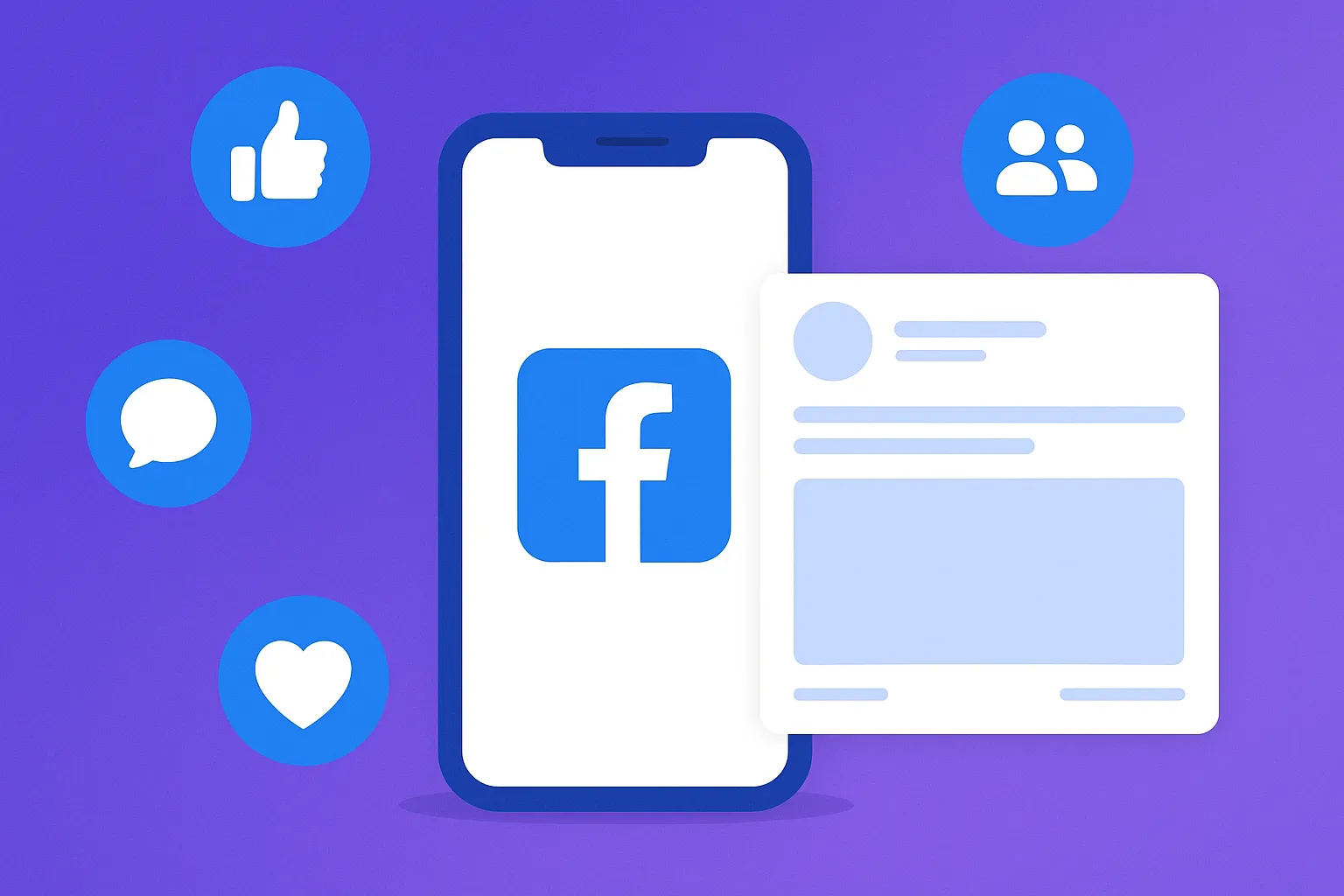Business Model of Facebook is not just about running a social networking site—it’s about operating a global business empire. Now part of Meta Platforms Inc., Facebook connects over 3 billion monthly active users with people, communities, and brands while powering one of the most profitable digital advertising machines on the planet.
Understanding the business model of Facebook is crucial for startup founders and tech entrepreneurs who want to build large-scale, ad-driven or engagement-based platforms. It’s a masterclass in monetizing free user access through data, personalization, and platform scalability. Whether you’re launching a social media app or planning a content-sharing platform, Facebook’s strategies offer valuable lessons.
What is Facebook & How It Works
What Problem Does Facebook Solve?
Facebook started as a way for college students to connect, but quickly scaled into a platform that solves one of the internet’s core needs: social connection. Whether it’s staying in touch with friends, discovering events, building communities, or engaging with content, Facebook provides a digital space for human interaction—globally, instantly, and freely.
It also solves problems for businesses and creators by offering tools to reach, engage, and sell to audiences.
Who Uses Facebook?
- Individuals who want to share personal updates, photos, or events
- Brands and businesses looking to advertise and build communities
- Influencers and creators engaging audiences through content
- Developers and partners integrating services via the Facebook API
How Does Facebook Operate?
Facebook operates on a two-sided platform model:
- User Side: Individuals use Facebook for free. They interact with posts, join groups, watch videos, message friends, and more. This generates vast amounts of behavioral and interest-based data.
- Advertiser Side: Businesses pay Facebook to place targeted ads in front of specific user segments. Facebook’s real-time auction model ensures advertisers reach the right people at the right moment.
In short, Facebook monetizes attention and engagement. The more time users spend on the platform, the more ad slots Facebook can sell.
Read More : What is Facebook App and How Does It Work?
Target Audience of Facebook
Facebook’s target audience is vast, but it can be broken down into several key customer segments based on usage patterns and value contribution.
1. General Users (Individuals)
- Age: 18–65+
- Purpose: Social networking, entertainment, content discovery, event planning, messaging
- Value: Drive engagement, data generation, and platform growth
2. Businesses and Brands
- Type: SMEs, corporations, e-commerce stores, local services
- Purpose: Advertising, audience engagement, lead generation, customer support via Pages
- Value: Primary revenue source through ad spend
3. Content Creators and Influencers
- Use: Share videos, live streams, and posts to build communities
- Monetize: Through ad breaks, brand partnerships, and fan subscriptions
- Value: Fuel engagement and time spent on the platform
4. Advertisers and Marketers
- Budget range: From small startups to Fortune 500 brands
- Use: Run paid campaigns using Meta Ads Manager
- Value: Core monetization engine
5. Developers and Platform Partners
- Use: Integrate login systems, build apps on Facebook, use analytics tools
- Value: Extend platform utility and data ecosystem
Features that Support the Business Model of Facebook
Facebook’s business model is powered by a set of features designed to maximize user engagement, collect data, and enable monetization at scale. Here are the key features that directly support its revenue generation:
1. News Feed Algorithm
- Personalized content keeps users scrolling longer.
- Shows a mix of friend posts, group activity, ads, and suggested content.
- More time = more ad impressions.
2. Facebook Ads Manager
- Offers precise targeting based on demographics, interests, behavior, and location.
- Includes tools for A/B testing, budget control, and real-time performance tracking.
3. Facebook Pages
- Designed for businesses, brands, and public figures.
- Acts as a free CRM and communication hub, increasing reliance on Facebook for outreach.
4. Facebook Marketplace
- Enables peer-to-peer buying and selling.
- Attracts local commerce activity and introduces commercial listings and promotions.
5. Groups and Communities
- Niche interest-based communities boost retention and time-on-platform.
- High engagement areas where advertisers can target specific audiences.
6. Video and Live Streaming
- Competes with platforms like YouTube and TikTok.
- Monetized through mid-roll ads, fan subscriptions, and stars (Facebook’s tipping system).
7. Facebook Pixel & API Integrations
- Allows websites and apps to track user behavior post-click.
- Helps advertisers retarget users and optimize campaigns—key for e-commerce conversions.
Read More : Best Facebook Clone Scripts in 2025: Features & Pricing Compared
Revenue Streams of Facebook
Facebook (under Meta) generates the bulk of its revenue through advertising, but there are additional monetization layers across its ecosystem. Here’s a breakdown of how it makes money:
Revenue Streams Overview
| Revenue Stream | How It Works |
| Advertising (Core) | Businesses pay to display ads across Facebook, Instagram, Messenger, and more |
| Facebook Marketplace Ads | Sponsored listings and paid product placements in local commerce |
| Creator Monetization | Ad revenue share, fan subscriptions, and tipping (Facebook Stars) |
| In-App Purchases | Users pay for virtual gifts, games, and stars for creators |
| Meta Business Tools | Paid business tools like advanced analytics, APIs, and integrations |
| VR/AR Hardware & Software | Meta Quest devices and content purchases (under broader Meta ecosystem) |
Quick Explanation of Each:
- Advertising (Core):
Facebook’s ad auction system allows advertisers to bid for impressions. This includes formats like image ads, carousel ads, video ads, and story ads. - Marketplace Ads:
Sellers and dealers can promote listings in Marketplace, targeting buyers based on location and interest. - Creator Monetization Tools:
Facebook shares revenue with eligible content creators who enable ads in their videos or receive fan subscriptions - Meta Business Tools:
APIs, business suites, and custom integrations for enterprises using Facebook’s platform for deeper insights and automation. - Meta Quest & VR Products:
While technically under the Meta umbrella, sales from Oculus (now Meta Quest) devices and apps also feed into the broader monetization model.
Read More : Revenue Model of Facebook: How the Social Media Giant Makes Billions
Cost Structure of Facebook
Running a platform at Facebook’s scale involves substantial ongoing expenses across technology, talent, infrastructure, and compliance. Here’s a breakdown of its major cost components:
1. Data Centers & Infrastructure
- Facebook handles billions of user interactions per day.
- Significant investment goes into servers, storage, cooling systems, and cloud infrastructure to ensure speed, uptime, and data security.
2. Research & Development (R&D)
- Covers product innovation, algorithm improvement, AR/VR exploration, and AI enhancements.
- Meta’s long-term vision with the Metaverse drives massive R&D spend.
3. Content Moderation & Safety
- Facebook employs AI and human moderators to enforce community standards and handle harmful content.
- Legal and regulatory compliance costs also fall under this category.
4. Employee Salaries & Talent Acquisition
- Top-tier engineers, data scientists, product managers, and designers are essential for innovation and operations.
- Talent retention and global hiring add to recurring expenses.
5. Sales, Marketing & Customer Support
- Marketing for Meta’s business tools and services.
- Support for advertisers, creators, and marketplace users.
6. Acquisitions & Partnerships
- Includes costs related to strategic acquisitions (like Instagram, WhatsApp) and partnership integrations.
7. AR/VR Development
- Investments in Meta Quest devices and the Reality Labs division.
- These future-focused initiatives have high R&D and operational costs but align with Meta’s long-term vision.
2024–2025 Innovations or Updates
Facebook (Meta) continues to evolve aggressively, especially as it competes in the social, AI, and metaverse spaces. Here’s what’s new or noteworthy in the 2024–2025 cycle:
1. AI-Powered Content Discovery
- Facebook has rolled out advanced AI recommendation engines to surface Reels, Groups, and Marketplace content more efficiently.
- This has increased user retention and session time, directly boosting ad revenue potential.
2. Creator Economy Expansion
- More monetization tools for creators, including automated ad placements in short videos and enhanced fan subscription models.
- Facebook now allows creators to link external shops and sell directly through their profiles.
3. Paid Verification (Meta Verified)
- Following trends from other platforms, Facebook introduced a paid verification system.
- It includes increased visibility, impersonation protection, and access to premium support—opening a new subscription-based revenue stream.
4. Privacy-First Advertising Solutions
- With growing data regulation, Facebook launched new ad measurement tools that rely less on personal data and more on aggregate performance modeling.
- Emphasis on contextual advertising and consent-based tracking.
5. AR Filters & Interactive Ads
- Interactive ad formats using AR and VR experiences are being tested, especially through Meta Quest and Instagram integrations.
- Useful for e-commerce and gaming brands looking to stand out.
6. Meta Quest + Facebook Integration
- Closer integration between Facebook and VR devices like Meta Quest for events, avatars, and social gaming.
- Building toward the broader metaverse vision.
Takeaways for Startup Founders
Facebook’s business model is more than just a playbook—it’s a blueprint for scaling user engagement into massive revenue. If you’re building a social platform, community-based app, or even a marketplace, here’s what you can learn:
1. Build a Free Product, Monetize Engagement
- Like Facebook, offer core services for free.
- Focus on maximizing user retention and session time—monetization follows attention.
2. Design for Two-Sided Value
- Serve both users and businesses.
- Let one side (users) fuel growth, while the other side (advertisers or sellers) funds your platform.
3. Leverage Data (Responsibly)
- Use behavioral data to personalize feeds, suggest content, or recommend products.
- Ensure transparency and privacy compliance to maintain trust.
4. Diversify Revenue Early
- Don’t rely on ads alone. Integrate features like subscriptions, premium services, marketplace fees, and in-app purchases.
5. Optimize for Mobile First
- Facebook is a mobile-first platform, and your app should follow suit.
- UX, speed, and notification systems matter.
Read more : Reasons startup choose our facebook clone over custom development
Why Build Your Facebook-Like App with Miracuves?
At Miracuves, we specialize in ready-made app solutions that are fast to deploy and fully customizable. Whether you want to replicate Facebook’s social networking model, marketplace features, or creator monetization ecosystem—we’ve got you covered.
- Launch faster with a white-labeled Facebook app
- Scale globally with built-in monetization tools.
- Get expert support for custom modules, API integrations, and growth.
Conclusion:
Facebook’s business model is a proven example of how to turn user engagement into a billion-dollar business. With multiple revenue streams—ads, subscriptions, marketplace tools, and creator monetization—Facebook shows how powerful a free-to-use, data-driven platform can be.
If you’re a founder thinking about building a social platform, don’t reinvent the wheel. Leverage Facebook’s model, avoid its early mistakes, and launch faster with a customizable solution from Miracuves.
At Miracuves, we help entrepreneurs like you build scalable, feature-rich platforms modeled after the best in the business. Our Facebook app solution gives you everything you need to start strong—from news feeds and groups to monetization-ready tools.
Start building your Facebook-like app with contact Miracuves today.
FAQs :
1. Can I make money with a Facebook-like app?
Absolutely. With the right features—ads, in-app purchases, subscriptions, and marketplace—you can monetize user activity and business demand just like Facebook.
2. Is it legal to build a Facebook app ?
Yes, as long as you don’t copy Facebook’s exact branding, logos, or proprietary code. A app mimics the functionality, not the IP. Miracuves builds legally safe, white-labeled apps.
3. How long does it take to launch a Facebook app?
With Miracuves’ ready-made solutions, you can launch your MVP in 2–4 weeks, depending on customizations and integrations.
4. What tech stack does your Facebook app use?
Our solutions use modern, scalable stacks like Node.js, React, MongoDB, and cloud-native infrastructure. Everything is optimized for performance, scalability, and security.
5. Can I add features like live video or marketplace later?
Yes. Our app platforms are modular. You can add or modify features anytime as your user base grows.
Related Articles :








